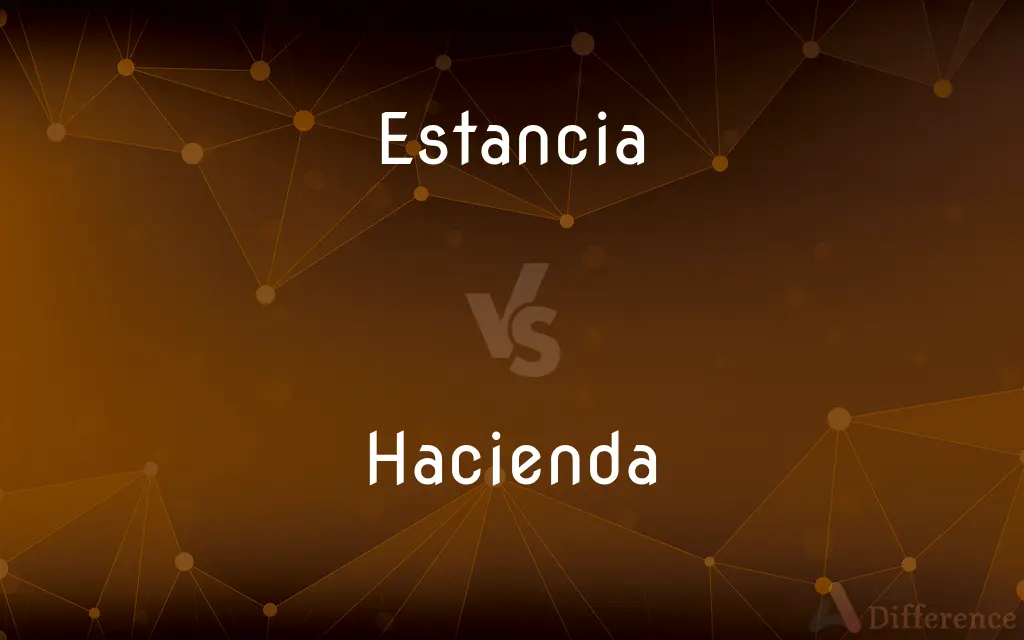Estancia vs. Hacienda — What's the Difference?
Edited by Tayyaba Rehman — By Fiza Rafique — Updated on March 19, 2024
Estancia is large ranches or cattle estates, particularly in South America, emphasizing livestock farming. Hacienda, while also a large estate, often denotes properties with a historical or colonial significance in Spanish-speaking countries.

Difference Between Estancia and Hacienda
Table of Contents
ADVERTISEMENT
Key Differences
An estancia typically denotes a large rural estate found in the South American regions, especially in countries like Argentina and Uruguay. These estates are primarily focused on extensive livestock farming, such as cattle and sheep. Whereas, a hacienda refers to a large estate or plantation with a dwelling house, predominantly found in Spanish-speaking countries. Historically, haciendas were significant agricultural enterprises involved in crop cultivation and sometimes included manufacturing.
Estancias are often vast territories of land dedicated to the grazing and breeding of animals. They are integral to the South American economy, especially in terms of meat and wool production. On the other hand, haciendas have a more diverse agricultural profile, often including various crops such as sugar, coffee, and corn, and might have played a role in the colonial economy through the encomienda system.
The architectural styles of estancias are generally simplistic and functional, designed to support the activities of ranching and herding. In contrast, haciendas can be much more elaborate, often reflecting the wealth and status of their owners with grand mansions, courtyards, and sometimes even chapels, showcasing a blend of Spanish colonial and indigenous architectural influences.
Estancias are usually more isolated, found in the open countryside to accommodate large herds of livestock and the necessary infrastructure for ranching. Haciendas, while also located in rural areas, were more likely to be integrated into local communities, providing housing and employment to a significant number of people, and sometimes even acting as centers of social and economic activity.
The social and cultural significance of estancias and haciendas also varies. Estancias have played a key role in shaping the gaucho culture, characterized by skilled horsemen and a deep connection to the land. Haciendas, on the other hand, were pivotal in the social and economic structures during the colonial era, often associated with the exploitation of indigenous and imported labor.
ADVERTISEMENT
Comparison Chart
Primary Focus
Livestock farming (e.g., cattle, sheep)
Agriculture and sometimes residential
Location
Predominantly in South America
Spanish-speaking countries, including Mexico
Architectural Style
Functional, suited to ranching activities
Elaborate, with colonial influences
Economic Role
Meat and wool production
Diverse crops, sometimes including manufacturing
Cultural Significance
Gaucho culture, horsemen, connection to land
Colonial history, social and economic centers
Compare with Definitions
Estancia
A large South American ranch focusing on livestock.
The estancia was home to thousands of cattle grazing freely.
Hacienda
A large estate with historical significance in Spanish-speaking countries.
The old hacienda was a reminder of the colonial past.
Estancia
Characterized by extensive open land for grazing.
Her dream was to ride across the vast lands of an estancia.
Hacienda
Involved in diverse agricultural practices.
The hacienda produced everything from coffee to sugarcane.
Estancia
Integral to gaucho culture and lifestyle.
Gauchos are the proud heart of every estancia.
Hacienda
Often features grand architecture and elaborate gardens.
The hacienda's gardens were a testament to its former glory.
Estancia
Primarily involved in meat and wool production.
The estancia's main income came from its high-quality wool.
Hacienda
Reflects a blend of Spanish and indigenous cultures.
The hacienda's architecture was a mix of colonial Spanish and local styles.
Estancia
Often found in remote, rural settings.
The isolated estancia offered breathtaking views of the untouched landscape.
Hacienda
Can be a center of community and social life.
The hacienda's chapel served as a gathering place for the local community.
Estancia
An estancia is a large, private plot of land used for farming or raising cattle or sheep. Estancias in the southern South American grasslands, the pampas, have historically been estates used to raise livestock, such as cattle or sheep.
Hacienda
A hacienda (UK: or US: ; Spanish: [aˈθjenda] or [aˈsjenda]), in the colonies of the Spanish Empire, is an estate (or finca), similar to a Roman latifundium. Some haciendas were plantations, mines or factories.
Estancia
A large estate or cattle ranch in Spanish America.
Hacienda
A large estate in a Spanish-speaking region.
Estancia
A large rural estate in Latin America; a kind of ranch.
Hacienda
The house of the owner of such an estate.
Estancia
A grazing farm; a country house.
Hacienda
A large homestead in a ranch or estate usually in places where Colonial Spanish culture has had architectural influence.
Hacienda
A large estate where work of any kind is done, as agriculture, manufacturing, mining, or raising of animals; a cultivated farm, with a good house, in distinction from a farming establishment with rude huts for herdsmen, etc.; - a word used in Spanish-American regions.
Hacienda
The main residence of a hacienda{1}.
Hacienda
A large estate in Spanish-speaking countries
Hacienda
The main house on a ranch or large estate
Common Curiosities
Can you find estancias outside of South America?
While estancias are characteristic of South American countries, similar ranching estates exist worldwide under different names.
What distinguishes a hacienda from an estancia?
A hacienda is often a large agricultural estate that may include residential structures and has historical significance, while an estancia is mainly a livestock ranch.
What architectural styles are common in haciendas?
Haciendas often feature Spanish colonial architecture with grand mansions, courtyards, and sometimes chapels.
What crops are commonly associated with haciendas?
Haciendas historically cultivated various crops, including sugar, coffee, and corn, depending on the region.
How do estancias contribute to local culture?
Estancias are key to the gaucho culture, symbolizing a deep connection to the land and skilled horsemanship.
How are haciendas preserved or utilized today?
Many haciendas are preserved as historical sites, and some have been converted into hotels or tourist attractions.
Is there a community aspect to haciendas?
Yes, haciendas often acted as centers of community life, providing housing and employment to locals.
What is the gaucho culture associated with estancias?
Gaucho culture, associated with estancias, celebrates skilled horsemen known for their prowess and deep connection to the rural lifestyle.
Are estancias involved in agriculture?
Although estancias focus on livestock, some may also engage in limited agricultural activities to support their needs.
What is the main purpose of an estancia?
An estancia primarily serves as a large livestock ranch, focusing on the breeding and grazing of animals like cattle and sheep.
How did haciendas affect the indigenous populations?
Haciendas often exploited indigenous labor under the colonial system, significantly impacting local populations and cultures.
Can estancias be found in urban areas?
Estancias are typically located in rural areas due to their need for extensive land for grazing.
What role did haciendas play in colonial history?
Haciendas were central to the colonial economy, often built on the encomienda system and exploiting indigenous labor.
What is the significance of the architectural design of estancias?
The architectural design of estancias is primarily functional, catering to the needs of livestock ranching and herding activities.
What is the economic significance of estancias today?
Estancias remain vital to the economies of their regions, particularly in the production of meat and wool.
Share Your Discovery

Previous Comparison
Hood vs. Canopy
Next Comparison
Cool vs. CoolyAuthor Spotlight
Written by
Fiza RafiqueFiza Rafique is a skilled content writer at AskDifference.com, where she meticulously refines and enhances written pieces. Drawing from her vast editorial expertise, Fiza ensures clarity, accuracy, and precision in every article. Passionate about language, she continually seeks to elevate the quality of content for readers worldwide.
Edited by
Tayyaba RehmanTayyaba Rehman is a distinguished writer, currently serving as a primary contributor to askdifference.com. As a researcher in semantics and etymology, Tayyaba's passion for the complexity of languages and their distinctions has found a perfect home on the platform. Tayyaba delves into the intricacies of language, distinguishing between commonly confused words and phrases, thereby providing clarity for readers worldwide.














































